Coroner’s road of death attack
Reporter: Richard Hooton
Date published: 29 September 2010
A CORONER has criticised Oldham Council for not swiftly remedying a substandard road that contributed to two fatalities.
Despite a substandard camber being identified after the first tragedy it took four more accidents and another fatality three months later before work was carried out.
Oldham Coroner Simon Nelson said that he had come very close to reaching a conclusion of neglect on the part of the authority. John Quinn (47), from Ashton, died after he crashed into an out-of-control car that had careered in front of his motorbike on the A672 Ripponden Road, Moorside, on May 5 last year.
The accident was blamed on the car driver losing control with the wet road and camber contributing. Mr Quinn’s family is considering legal action against the driver and council.
A second inquest into the death of Benjamin Jessop (24), from Barnsley, on August 10, last year — at the exact same spot — resumed at Oldham County Court yesterday. Mr Nelson again recorded a verdict of accidental death and said the camber and wet conditions contributed to a driver losing control.
Natalie Fletcher (21) was driving Mr Jessop and another work colleague on a business trip to Leeds when she lost control of the Hyundai on the notorious Besom Hill bend in wet conditions and careered onto the wrong side of the road.
A bus travelling the other way hit the side of the car with back seat passenger Mr Jessop taking the brunt of the impact. The trainee sales manager died from multiple injuries.
Miss Fletcher blacked out after the crash but was able to get out of the car when she came round shortly after.
But in police interviews she said she had no memory of before or during the accident and could only remember waking up in hospital. She had suffered a head injury and was in hospital for a week.
She said she had tried to jog her memory but was diagnosed with post traumatic stress and depression. She insisted she would "never drive like an idiot."
Miss Fletcher was arrested on suspicion of causing death by dangerous driving but no criminal charges were ever brought.
John Bodkin, from Garstang, was in a car being driven by his wife when they were overtaken by Miss Fletcher moments before the crash. He described it as a "very aggressive" manoeuvre and said that, as his wife commented she was driving at 40mph, he estimated the Hyundai was doing 50mph. A previous witness in a car behind estimated that Mrs Bodkin was driving at less than 30mph.
Mr Bodkin added: "After the car overtook us it increased speed significantly. It was just going too fast and considering there was a bend to be taken I couldn‚t believe how fast it was travelling."
But he said the Hyundai returned to the correct side of the road and braked quickly before the bend. As his wife‚s car went round the bend he saw the aftermath of the accident.
Senior Collision Investigator, PC Mark Dickman, concluded that primarily driver error was to blame but he couldn't rule out that the wet road and substandard road surface were contributory factors.
There had been 11 other similar collisions in the previous six years and many more may have gone unreported. But there have been no accidents since the remedial work was carried out.
New council head of highways, Phil Matley, said the road had been resurfaced in 2003 and inspected regularly with no visual defects spotted.
It was due to be resurfaced in 2008 after anti-skid failures but the work wasn‚t carried out because the engineer responsible fell seriously ill.
The coroner said it seemed bizarre that such important work was the responsibility of one employee but Mr Matley assured him that a system was in place to stop it happening again.
After the May 5 fatality the camber problem was identified. But because of further accidents the council decided on July 17 that another survey was needed.
Mr Matley insisted it wasn‚t a case of doing nothing for ten weeks but that a series of discussions were held into what action to take. But he admitted there were no minutes available of these meetings.
He said resources were "uniquely" stretched by another high-profile road accident, the death of 15-year-old pedestrian Christopher Dale on Lees Road on June 13.
After another accident on July 26 - the fourth on the bend since the May fatality - it was agreed a new surface dressing was needed. At a meeting on August 4 it was agreed it would be difficult to resurface the road at that time of year so anti-skid surfacing would be done. This was started a few weeks after Mr Jessop's death. Work to solve the problem long-term is due to start within 18 months.
The coroner said he would have to find there had been a gross failure on behalf of the council to reach a conclusion that neglect had been a contributory factor.
He added: "I could not find gross failure on the part of the authority. But I am not particularly impressed with the manner the authority has dealt with the remedying of the surfacing following the untimely death of Mr Quinn."
He said he hoped the circumstances are not repeated and that steps to remedy any road surface suspected of being substandard and contributory are documented and undertaken on a timely and efficient basis.
Most Viewed News Stories
- 1New nursery moving into basement of old people’s home
- 2Councillor challenges village post box issues
- 3‘Completely inappropriate’ caravan park plans rejected
- 4Six arrests secured as police Operation Vulcan drive continues to tackle drug importation in Derker...
- 5Major rule changes beckon for bus pass holders





